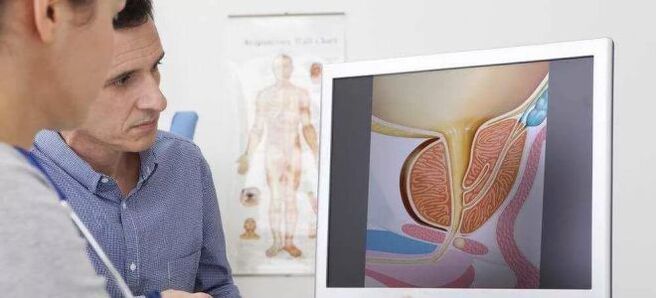
Prostate diseases are often first in men of reproductive age. Their causes and types are different. The most common pathology is prostatitis - inflammation of the prostate gland. The insidiousness of the disease lies in the fact that the symptoms of prostatitis in men are latent for a long time.
What is the prostate in men?
The prostate gland is an accessory sex gland in the male reproductive system. Its shape resembles a chestnut. The mass of the instrument ranges from 12–20 g. In its structure, the prostate resembles a sponge, consisting of many small cavities in which the secretion of the prostate gland is formed. Through many tiny ducts, the secret enters the urinary canal during sexual intercourse.
The body is divided into 3 zones:
- cranial;
- average;
- tail.
According to the observations of doctors, the pathologies are mainly affected by the waist and tail zone. Neoplasms, malignant tumors are located directly in them. Given these characteristics, if pathology is suspected, experts examine these areas of the prostate among the first.
Where is the prostate located?
The prostate gland in men is activated and begins to develop with the onset of puberty. This process is controlled by sex hormones. This androgen-dependent organ is located below the bladder. Through the prostate passes the initial part of the urethra. The excretory ducts of the prostate open into the urethra.
Considering the pelvis as a whole, we can say that the prostate is in the center. It wraps around the bladder neck and proximal urethra. With its apex, the prostate gland is in contact with the pelvic diaphragm, above which is the external sphincter of the urethra. Dorsally, the gland borders the ampulla of the rectum, through which a digital examination of the prostate is often performed.
%20in%20a%20man.jpg)
What is the protector responsible for?
The functions of the prostate are as follows:
- The production of fluid that forms the liquid part of the semen.
- Conversion of testosterone to its active form, dihydrotestosterone.
- The formation, together with the muscles of the neck of the bladder, the internal sphincter, involved in the process of urination.
- Participation in the process of the act of ejaculation.
Prostatitis - types
Before highlighting the main symptoms of prostatitis in men, it is necessary to consider the existing types of the disease. Inflammation of the prostate, depending on the form of the violation, the clinical picture is divided into the following types:
- Acute prostatitis- severe inflammation of the prostate gland, which develops as a result of a bacterial infection.
- Chronic bacterial prostatitis- characterized by a slow course, periods of exacerbation alternate with depression.
- Chronic pelvic pain syndrome- a difficult-to-diagnose form of prostatitis, manifested by constant pain in the pelvic area.
- Asymptomatic chronic prostatitis- does not have a pronounced clinical picture, it is detected randomly, according to the results of a urinalysis.
- Granulomatous prostatitis- considered as a side effect of drug treatment for other diseases. The prostate tissue is gradually replaced by connective tissue.
Inflammation of the prostate - causes
Inflammation of the prostate in men can have several causes. However, in most cases they are associated with a neglected attitude of the stronger sex to their health.
Among the factors that cause the development of pathology, doctors call:
- infections of the genitourinary system.
- circulatory disorders in the pelvic organs due to a sedentary lifestyle.
- prolonged absence of sexual relations, cessation of sexual intercourse.
- reduced local immunity.
- frequent hypothermia;
- hormonal imbalance in the body.
- lack of vitamins and minerals;
- non-compliance with the rules of personal hygiene.
Infectious prostatitis
Inflammation of the prostate gland of an infectious nature is a consequence of the entry of pathogenic microorganisms into the prostate. The process can proceed in an acute or chronic form.
Provocative factors play an important role in the development of infectious prostatitis, such as:
- severe hypothermia of the body.
- stressful situations;
- increased physical activity;
- bad habits (nicotine, alcohol);
- Diabetes;
- hypothyroidism;
- HIV.
Non-infectious prostatitis
Chronic inflammation of the prostate in most cases is not infectious. The factors that contribute to the development of this form of pathology are not fully understood.
Possible experts include:
- irregular sex life;
- hormonal disorders in the body.
- increased body weight;
- sedentary type of work.
- constant stress;
- genetic predisposition?
- constipation.

Signs of prostatitis in men and its symptoms
Symptoms of prostatitis in most cases go unnoticed for a long time. Periodic pain in the groin, violation of sexual function, many men consider as a temporary phenomenon. In 90% of cases, the development of inflammation of the prostate gland is manifested by a decrease in sexual activity, problems with ejaculation and difficulty urinating. In the acute form, the disease is accompanied by a deterioration in general well-being.
When a flare-up of prostatitis occurs, the symptoms in a man are as follows:
- increase in body temperature;
- general weakness;
- increased sweating;
- pain in perineum, radiating to anus and pubic cavity.
- difficult urination.
The first symptoms of prostatitis
The first symptoms of prostate inflammation in men to look out for is sexual dysfunction. A man complains of worsening erection or its complete absence. Ejaculation is also disturbed, orgasm weakens. Similar symptoms of prostatitis in young men negatively affect sexual relations, so they soon begin to avoid them in order not to fall into the eyes of their lovers. This leads to mental depression, constant tension and anxiety, which worsens the condition.
Symptoms of prostatitis - what hurts?
Painful sensations with prostate inflammation appear mainly with the development of an acute form of the disease. Their location may be different. Thus, back pain with prostatitis is corrected by about 50% of patients. In most cases, men experience excruciating pain in the perineum, scrotum, radiating to the sacrum.
The intensity of painful sensations can vary: from pain, unpleasant sensations to pain that does not allow you to fall asleep at night. Increased pain can be noted during sexual intercourse, with excessive sexual activity, during ejaculation. These symptoms of prostatitis in men often appear among the first.
Urination with prostatitis
Taking into account the inflammation of the prostate, the symptoms of the disease, among other signs, doctors distinguish a violation of the urination process.
Patients often complain of the following nature:
- frequent urge to urinate.
- lack of feeling of empty bladder after toilet.
- difficulty urinating.
Typical events:
- In most cases, it all starts with the fact that a man cannot empty his bladder normally. The prostate, inflamed, increases in volume and gradually compresses the urethra.
- Progressive inflammation leads to the development of induration of the bladder neck. As a result, the patient has a frequent urge to go to the toilet.
- The chronic form is characterized by nocturnal enuresis: a man is forced to get out of bed and go to the toilet in the middle of the night.
- All this is accompanied by unpleasant sensations in the groin. Sometimes, these are the only symptoms of chronic prostatitis.

Distributions for prostatitis
Speaking about the symptoms that can be observed with prostatitis, doctors also mention rejection from the genital system among the possible manifestations of the disease. The most common of these disorders is promenorrhea. It occurs with a decrease in the tone of the prostate gland and indicates the presence of an inflammatory process in the gland. In such cases, the discharge occurs after the act of urination or defecation.
The consistency of the secretion from the genital system resembles a thick, whitish-milky liquid. When in the prostate, in addition to inflammation, there are also infectious agents, the color of the secretion changes to translucent with a yellowish tint. At the same time, the man notes intense discomfort in the anus and itching in the urethra.
Distributions are most often noted during the day, after active movements, the application of prostate massage. Similar symptoms of prostatitis in men are forced to consult a doctor and undergo an examination.
temperature for prostatitis
Acute inflammation of the prostate in men is always accompanied by hyperthermia. Body temperature with a similar disease often rises to 39 degrees.
A man notices the appearance of the following symptoms:
- sharp pains in the lower abdomen.
- pain in the perineum;
- pain in the process of emptying the bladder.
- discomfort and discomfort during bowel movements.
The temperature in most cases appears only at the beginning of the inflammatory process. Over time, after taking antipyretic and anti-inflammatory drugs, its normalization is observed. The lack of treatment and medical care at this stage is fraught with the progression of prostatitis and the transition of the disease to a chronic form.
Why is prostatitis dangerous?
Doctors recommend starting treatment with the appearance of the first clinical symptoms of the disease. For this, a man should contact a urologist already if he is suspected of having a disease. The consequences of prostatitis can be very different: from sexual dysfunction to conception problems and secondary infertility. The probability of developing such a pathology is 40% in the absence of proper treatment. The most terrible complication is prostate adenoma - a tumor of a malignant nature.
Other negative effects include:
- neurosis;
- abscess;
- depression and apathy.

























